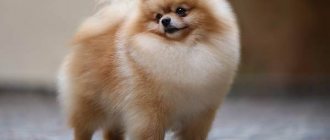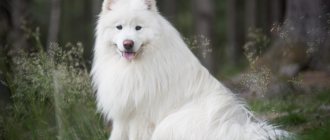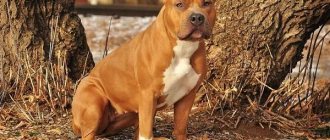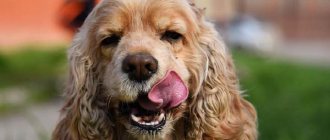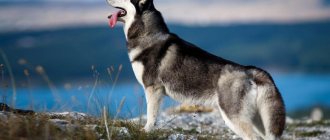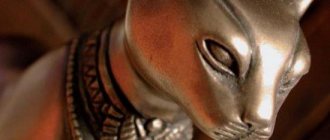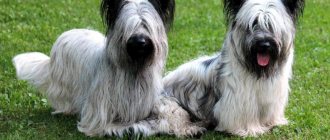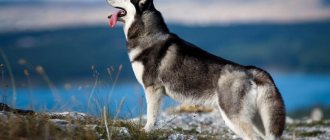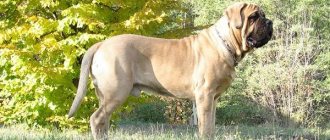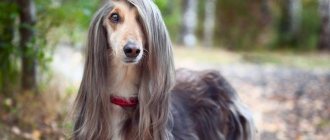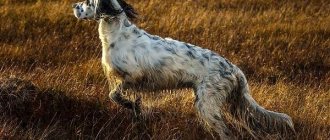If everyone had the same dog, the world would be a much less interesting place. Most of us are familiar with standard dog breeds, but there are also some very unusual, if not downright bizarre, breeds. We have collected information about the twenty most unusual dog breeds in the world today. Some of them you will easily recognize, while others are so few or new that they have not yet been recognized even by the International Kennel Club.
Here's our selection of the weirdest dog breeds:
Komondor
The Komondor breed originated in Hungary. This is one of the largest dogs in the world. In adulthood, this Hungarian Shepherd has an average height of 76 cm at the withers. It looks even larger due to its huge coat, which is by far the thickest in the canine world.
The Komondor is one of the shaggiest breeds. In appearance, he resembles the world's largest mop with hair that has a tangled, almost dreadful appearance. This unusual-looking dog has fur so long that its eyes cannot even be seen through it, so many people reasonably wonder how a Komondor can see through a thick veil of hair.
Lancashire Heeler
The story of the Lancshire heeler 150 years ago is well known. In north-west Britain, the dog performed a variety of agricultural tasks. Then she practically disappeared. In the middle of the last century, the rebirth of the breed began. Only in 2016, the FCI association included the Lanksshire Heeler on the list of temporarily accepted breeds.
The dog is short, short-legged, with large ears. Height: 26-30 cm at the withers, weight: no more than 5.5 kg, usually about 3.5 kg. The coat is short, shiny, lying close to the body. The color of the cover is black or brown with light tan marks. The dog is smart, full of optimism. Nowadays he copes well with the role of a companion.
Bedlington Terrier
This terrier variety is named after its place of origin - Bedlington, England. In truth, it is difficult to distinguish this dog from a sheep. The Bedlington Terrier is similar in appearance to a standard-sized poodle, but its gray, tightly curled coat is as thick as sheep's wool. In addition, the Bedlington Terrier's coat is famous for its hypoallergenicity.
This is an interesting breed with a rather quirky appearance. The body from the side looks like an inverted letter S with curvy contours. This breed is truly one of a kind and is included in the list of the rarest dogs in the world. If you don't mind the Bedlington Terrier's strange appearance, it makes an excellent four-legged companion for people prone to allergies. In addition, the Bedlington Terrier's temperament is cheerful and peaceful.
Swedish Vallhund
Swedish Vallhunds are athletic dogs characterized by obedience, agility, and hard work. In addition to this, they are traditionally farm dogs used for herding livestock. The “small, powerful, fearless” breed comes in a variety of colors and tail lengths, from none at all to a beautiful curl. This is a sociable and cheerful dog, it will find contact with both children and adults.
Bullets
Pulis are definitely one of the most unique dog breeds. He has an unusual Jamaican-style coat that cascades downwards, giving Puli the appearance of a hairy barrel on four short legs.
This type of shepherd dog, which looks like a smaller version of the Komondor, also comes from Hungary. It was originally bred in the Middle Ages as a working dog to help herd livestock. Therefore, puli is famous for its endurance and unpretentiousness. Puli wool, with its tightly curled dreadlocks, is actually quite unusual in appearance, and one of its most interesting properties is its high resistance to water.
Thai Ridgeback
It is interesting that most of the rarest and most unusual dogs are also the most ancient. It’s as if people got too carried away with breeding dogs and gradually began to forget where it all began. Research shows that Thai Ridgebacks are very similar to the Dingo dog, meaning they are most likely quite closely related. By the way, scientists believe that today it is one of the most pristine and original breeds. Scientists still argue that the dogs were bred, but for quite a long time their distribution was limited to Thailand, Vietnam, Cambodia and Indonesia. In ancient times, this area was highly isolated due to poor transport connections, this whole situation led to the fact that Thai Ridgebacks were protected from crossing with other breeds. Despite the fact that the breed has ancient origins, it was registered by the International Canine Federation only in 1993, for this reason its distribution was limited.
Russian greyhound
The Russian Greyhound, of course, was originally bred in Russia. The dog's body shape is similar to a greyhound, but its coat is unique in that it is smooth on top and becomes thicker and curlier near the belly and legs. These unusual-looking dogs are a nightmare for trainers. They are famous for their stubbornness and excessive independence. The Russian Greyhound is quite active and loves to hunt and chase small animals.
Brussels Griffon
At first glance, the Brussels Griffon makes one think that the Ewok from the Star Wars saga escaped and crossed with a terrier. This strange looking little dog doesn't realize he's a small dog breed. The Brussels Griffon walks around the yard looking for someone to intimidate. Brussels Griffons usually try to dominate other dogs in their area. They are confident dogs who proclaim their dominance, so it is important to start training them from day one and make sure they know that you are the dominant part of the equation.
Karelian bear husky
It is believed that the dogs that became the basis for this breed were found in Karelia back in prehistoric times. In the 20th century, the breed began to be formed purposefully. The wars of the last century almost destroyed the breed. Fortunately, the bear's husky was able to be revived.
The dogs are created and successfully perform the hunting task of baiting large and medium-sized animals. The breed is of medium height, no higher than 60 cm, no heavier than 23 kg. The dogs are very unpretentious, can withstand prolonged cold, and are extremely hardy. The character matches the northern nature - harsh.
Affenpinscher
The Affenpinscher was first bred in Germany for the purpose of hunting rats. This strange-looking dog is of medium size and build, and although there is nothing unusual in the shape of its body, its main feature is its coat. The Affenpinscher is covered in brown or dark gray (almost black) curls, with some parts of its body appearing shaggier than others, giving these small dogs a ragged appearance. However, the fur is so unusual and bizarre that it looks quite stylish and extravagant. Affenpinschers like to be busy both mentally and physically, otherwise they may develop unwanted behavioral problems.
Neapolitan Mastiff
Imagine a sumo wrestler turned into a dog, and you get the Neopolitan Mastiff. This large breed of dog is one of the most unusual in appearance. Just the sight of a Neopolitan Mastiff is enough to make you very scared. In adulthood, it weighs up to 59 kg. He has a huge body mass and excessively saggy skin, especially on his neck.
However, try not to be too intimidated by the appearance of the Neopolitan Mastiff. It makes one of the most effective guard dogs on the planet. Neapolitan Mastiffs are famous for their loyalty and sociability, but it is not recommended for families with young children to have them. The Neapolitan Mastiff is a jealous owner who shows his jealousy through aggression.
What breeds are very few in Russia?
The least common in Russia are:
- Carolina dogs are recently domesticated animals, well adapted to droughts and high temperatures and cannot tolerate cold;
- Mudi - little-known Hungarian shepherd dogs;
- Norwegian Lundenhunds are Norwegian huskies, highly specialized hunters who, thanks to their special body structure, can climb rocks and get into holes;
- Thai Ridgebacks are the national breed of Thailand, considered one of the oldest known to man.
Exotic pets attract attention due to their unique appearance. But before you bring them into your apartment or house, it is important to realize that such animals require increased attention and constant painstaking care.
Bergamasco Shepherd
The Bergamasco is one of the most unique dog breeds, not only because of its original appearance, but also because the puppies are completely different from adults. This Italian herding dog breed is born with short, smooth hair. As puppies grow older, their hair grows longer until it becomes long, knotty locks that extend down their body a dozen centimeters. Adult Bergamasco Shepherds look like they really need a trip to the groomer.
Where did rare breeds come from?
Exotic dogs create their own category due to several factors. It may be a rare breed due to difficult breeding, low popularity, or the result of selective breeding. Unusual dogs most often appear when new crossbreeding methods are used. The work of breeders is not always successful, so some species never gain popularity and remain living in one region.
A dog without a nose is a bull terrier breed
Bull Terrier
Most of us are familiar with this British breed. Bull Terriers have an unusual egg-shaped head. Add to this the sharp, pointed ears and slanted eyes, and you get something of a curiosity in the dog world. Another physical feature that makes this dog so damn weird is its massive body with muscular limbs. The Bull Terrier is an active breed that requires a high level of physical activity.
French Bulldog
French Bulldogs are famous for their affectionate and gentle nature. They are small lap dogs that never seem to get enough attention. They were originally bred as fighting dogs. Spectator sport was cruel and fell out of fashion, which is a plus for this strange looking little dog with a sad face.
The French Bulldog is a muscular, compact dog with a small muzzle, flattened nose, erect bat ears and expressive eyes. The tail is naturally short. Despite its tiny size, the French Bulldog is a fierce protector of its family. His character is cheerful and sociable. The breed is extremely active and playful.
Brazilian Fila
This breed was the result of crossing a mastiff, an English bulldog and a bloodhound. The Fila Brasileiro is a large-boned mastiff with large bones and a massive body. This huge dog is covered in loose skin with a smooth, brindle-colored coat. The muzzle is drooping with wrinkles that cascade down the neck and sway when running. The Fila Brasileiro borrowed this feature from the Bloodhound.
The Fila Brasiliensis was originally bred to be a tracker. Over almost a century of existence, he has created a reputation for himself as a dog with a stubborn disposition and aggressive temperament. So the Brazilian Fila is an excellent guard dog that does not tolerate strangers at all.
Catalburun
The Catalburun dog breed is one of the rarest in the world. They come from Turkey and were originally bred as hunting dogs. What really makes this breed one of the most bizarre is the forked nose. Add to this the long floppy ears and you have a strikingly strange-looking dog. It is believed that the reason the Catalburun have such an odd appearance is that due to their rarity, they have been massively inbred, resulting in unattractive physical characteristics.
Rare types of dogs up to 50 cm at the withers
Small exotic pets are no less popular among dog breeders than large dogs. Among them are:
- Lancashire Heeler - miniature, stocky herding dogs;
- Prague Ratcatcher - excellent rat catchers, bred in the Czech Republic, in the past and companions and status pets in the present;
- Chiweenies are touching, friendly and affectionate representatives of the canine world, incredibly popular in the USA;
- Swedish Vallhound - an ancient Scandinavian breed bred as a cattle driver;
- Chongqing are rare hunting dogs that originated in China.
Chongqing has an ancient history
New Guinea singing dog
This dog makes our list because of its unique voice. Its howl resembles the singing of birds or whales. If you've never heard a dog sing before, this is your chance because he will serenade you day and night.
Externally, the New Guinea Singing Dog looks like a large fox with wide, pointed ears. This dog was once a wild subspecies of the wolf that was tamed. The New Guinea Singing Dog is renowned for its intelligence, flexibility and agility. They are also fantastic climbers.
Levchen
More often the breed is called the small lion dog. In 1973, the number of these animals reached a minimum: only 65 individuals remained. Nowadays, more than a hundred purebred Levchens have been registered. Once upon a time, these dogs were present in all the aristocratic houses of Europe.
Lewchens are long-haired dogs belonging to the Bichon group. Their usual weight is 3-4 kg, maximum - 6 kg. The coat is neither straight nor curly, but rather wavy and quite hard. The wool does not fly away and does not accumulate dust. Because of this, long-haired Levchens have minor allergic effects. Otherwise, Lewchens differ little from other Bichons and lapdogs.
Moody
Mudi is a herding dog originally from Hungary. They were bred in the Middle Ages to herd and protect flocks of sheep. This is an unusual looking dog with dense, fluffy curls of gray, black, brown or ash color. In fact, the Mudi looks like a cross between a dog and a llama, with a long neck and curly hair.
The Mudi is one of the most versatile and multi-talented dog breeds in the world. In addition to being good herding dogs, they are also excellent hunters and rodent exterminators. This dog should not be kept in small confined spaces. Due to its nature, the Mudi requires wide open spaces in which it can move freely. If the Mudi is kept in small areas, he will need to go on long daily walks.
Basenji
The history of this dog breed, which originated in central Africa, goes back more than five thousand years. Basenjis have quite a few unique features that make them impossible to confuse with other dogs. First of all, they can't bark. Yes, yes, this is really a dog that is not capable of barking in the usual sense of the word. Instead of barking, Basenjis make characteristic sounds like purring, but they can only be heard when the dog is excited. Secondly, when a dog pinches its ears on its forehead, it develops funny wrinkles, just like a human. Well, the last feature is the tightly curled tail. It may seem surprising, but Basenji dogs do not have the unpleasant odor that appears in all other breeds some time after bathing. Often a dog can be caught washing itself, exactly the same as cats do. Basenji wool is also considered hypoallergenic. It is worth mentioning that Basenji litters are very small; on average, 4-5 puppies are born; other dog breeds can produce up to 15 puppies at a time. Maybe this is the reason for their rarity?
Lagotto Romagnolo
It is also called the Italian water dog. This breed originates from the Romagna region of Italy. They were first bred as hunting dogs, but have evolved into some of the best truffle hunters in the world. What makes them so unusual is that they have the face of a Brussels Griffon and the body of a standard-sized large poodle.
The coat of the Lagotto Romagnolo most closely resembles a dirty carpet with thick tufts of tight curls covering the entire body of the dog, with the exception of the muzzle area. The color of the fur can be of all shades of brown, from pale yellow to dark brown. Less common are Lagotto Romagnolos that are white or mixed in color.
Azawakh
This breed of greyhound originates in West Africa. While there is no doubt that the Azawakh is graceful in appearance, its elongated neck appears stretched to an abnormal size. This configuration makes the head look too small.
The Azawakh is known to have an intelligence that is well above average in the canine universe. It has a short coat that comes in a wide variety of colors and markings. Azawakhs make excellent companions; they are selflessly devoted to their owners and fiercely protect them.
Peruvian hairless dog
This breed has several names: Calato, Peruvian Inca Orchid, Viringo and Inca Hairless Dog. This is perhaps one of the most bizarre dogs on Earth. The Peruvian Hairless Dog is an ancient breed that originated in Peru around 750 AD. Despite its centuries-old history, this breed is not very common throughout the world.
The Peruvian Inca Orchid is one of the rarest species in the world. Some dogs of this breed are completely hairless, with a few tufts of hair on the top of their heads. This gives them a unique, but slightly off-putting appearance. They are highly prized for their hunting instincts, intelligence, speed and agility. The colors of fur and skin are very diverse.
Xoloitzcuintle or Xolo
This breed is considered a state treasure in Mexico. The name, no less outlandish than the dog itself, comes from the language of the Mexican Indians, often pronounced differently: sholoitzcuintle or sholo. In the Nahuatl language, the name of the dog reveals the divine origin of the animal: “dog of the god Xolotl.”
The Mexican Hairless Dog (this is another name for it) is considered the oldest breed. Their mummified bodies are found in the tombs of the Mayans, Aztecs, and Zapotecs. Burials, drawings and figurines of hairless dogs are over 3,500 years old. Canine standards describe three sizes of dogs:
- large, height from floor to withers 60 cm;
- average, height up to 45 cm;
- small, height up to 35 cm.
Xolo is a slender, hairless dog. Her features include almond-shaped, slightly protruding eyes; big ears a la “bat”; long neck. Body hairlessness is not an absolute sign. One litter may contain hairless and furred puppies. The coated Xolo is believed to be the original version of the Xoloitzcuintle dog breed.
Catahoula Leopard Dog
This breed originates in the United States in Catahoula Parish, Louisiana. It is believed to be the first dog first bred in the United States. When you look at a Catahoula leopard dog, the first thing you see is its striking, bright eyes. Although eyes come in a variety of colors, blue eyes are considered the most striking. They contrast well with a spotted coat, which is often a mixture of various whites, browns, grays and reds in a swirl of spots. The Catahoula Leopard Dog comes in a variety of colors, but leopard-like spotting is present on all members of the breed. This dog is used primarily for hunting wild boar in the southern states of the country.
TOP 25: The strangest dog breeds
Almost everyone knows that there are certain dog breeds, such as the Golden Retriever and the German Shepherd, but did you know that there are many more, and some of them are truly unusual? Dogs come in all shapes, sizes, and temperaments, but honestly, some dogs' appearances defy common sense. Covered in thick, shaggy fur or with oddly shaped bodies, these dogs are worth a look. But just because they look weird doesn't mean they aren't cute or worth bringing into your home. Are you ready to see strange dogs? Here are 25 of the most amazing dog breeds. 25. Bull Terrier
Photo: commons.wikimedia.org
Bred in the 19th century as a fighting dog, the Bull Terrier is quite a fearsome looking dog. However, they are said to be actually quite friendly dogs suitable for families. The strangest part of this breed is the dog's unusual egg-shaped head.
24. Brazilian Fila
Photo: commons.wikimedia.org
The Fila Brasil, also known as the Brazilian Mastiff, was bred as a hunting dog. He is also a guard dog and herds livestock. Did we mention that it can also hunt big game like a jaguar? You don't want to mess with this dog. They are very loyal and hate being touched by strangers.
23. Moody
Photo: commons.wikimedia.org
Bred in Hungary to herd sheep, the Mudi is extremely fast and has a very thick coat. While most members of this breed are black in color, there are dogs of the rare "cifra" color - with dark and light gray coats that may have spots or marbled patterns.
22. Catahoula Leopard Dog
Photo: commons.wikimedia.org
The Catahoula Leopard Dog is also distinguished by its marbled spotted coat, which gives it an unusual appearance. Bred in North Louisiana to herd hogs, these animals are good family dogs, affectionate and excellent protectors.
21. New Guinea singing dog
Photo: flickr.com
There is a good reason why they are called New Guinea Singing Dogs. Their howl is unlike anything you've ever heard before, but while you can see a dog like this on video, you're unlikely to be able to hear it in person. In New Guinea they are extremely rare wild dogs. 20. Lagotto Romagnolo
Photo: commons.wikimedia.org
The Lagotto Romagnolo is a unique Italian breed that would have almost become extinct if a group of dog breeders had not been able to preserve it. These dogs have a unique thick, curly coat, and they were bred specifically for hunting waterfowl and searching for truffles.
19. Otterhound
Photo: Pxhere.com
The Otterhound was bred to do exactly what its name suggests - hunt otters. Of all the animals you can hunt, the otter is a rather strange choice. This breed has a keen sense of smell and a very long, shaggy coat.
18. Neapolitan Mastiff
Photo: en.wikipedia.org
Large, wrinkled and ugly, the Neapolitan Mastiff was bred to be a guard dog but is today considered a "gentle giant."
17. Affenpinscher
Photo: commons.wikimedia.org
The Affenpinscher is a tiny companion dog originally bred to catch rats. But honestly, she looks like the Ewoks from Star Wars.
16. Thai Ridgeback
Photo: commons.wikimedia.org
The Thai Ridgeback is a primitive dog breed from Thailand that was used for hunting and harnessed to carts. Although, like most primitive breeds, they are very difficult to train.
15. Norwegian Lundehund
Photo: commons.wikimedia.org
The Norwegian Lundehund is a very strange dog, it has six toes on each foot, two of which are connected into a common system. The dog was originally used to climb rocks and retrieve eggs from petrel nests. This breed also has some pretty amazing acrobatic talents with a wide range of movement.
14. Brussels Griffon
Photo: en.wikipedia.org
Another dog similar to the Ewok is the Brussels Griffon, a former Belgian mongrel bred to hunt rats. This breed has a fairly high intelligence and sense of humor, so it always keeps its owners on their toes.
13. Shar Pei
Photo: commons.wikimedia.org
Looking like a pile of wrinkled laundry with a snout, the Shar Pei was bred to guard, hunt and fight, but is now simply a beloved companion dog for many owners.
12. Tibetan Mastiff
Photo: commons.wikimedia.org
This primitive Tibetan breed is known for its fluffy coat, especially on the top of its head. The dog was bred to guard livestock, but today is widely used as a show breed.
11. Phu Quoc Ridgeback
Photo: commons.wikimedia.org
Phu Quoc Ridgeback is a very rare breed of dog from the Vietnamese island of Phu Quoc. Since this breed was isolated on the island for a long time, the dogs boast a good pure pedigree. The breed got its name from the peculiarity of the fur growing on its back: it grows in the opposite direction from the hair on the rest of the body.
10. Azawakh
Photo: WikipediaCommons.com
The Azawakh breed originates from the Sahara Desert and is a tall, thin dog with very long legs. They are hunters, loyal and capable of protecting their homes.
9. Russian Greyhound
Photo: commons.wikimedia.org
With an unusually long nose, the Russian Greyhound looks more like an anteater than a dog. They were bred and trained to hunt hares, foxes and wolves in packs of three. Much later they became companions of the kings.
8. Xoloitzcuintle
Photo: commons.wikimedia.org
Good luck pronouncing its name! This dog is also called the Mexican Hairless Dog and is believed to be descended from the first dogs to walk on North American soil. People love to hug them because dogs give off warmth from their bodies.
7. Pumi
Photo: commons.wikimedia.org
The Pumi is a newer but also rare breed with a small number of litters originating in the United States. This breed comes from Hungary and is descended from the Puli breed.
6. Dandie Dinmont Terrier
Photo: commons.wikimedia.org
Looking like he just got a curl at the barbershop, the Dandie Dinmont Terrier was bred to hunt otters and badgers. This is a calm and reserved breed that is considered the "gentleman of the terrier family."
5. Bullets
Photo: commons.wikimedia.org
The Puli breed has a thick, shaggy coat that is hard to believe dogs can see through. But don't be fooled, this is a rugged herding dog and is often seen at dog shows.
4. Bergamasco Shepherd
Photo: commons.wikimedia.org
The Bergamasco Shepherd looks like a big carpet. Her long fur is unlike anything we have ever seen.
3. Bedlington Terrier
Photo: commons.wikimedia.org
The Bedlington Terrier looks like a space alien. With a thick, curly coat and floppy ears, the breed was once used for rat hunting and is often seen today at dog shows.
2. Chinese Crested Dog
Photo: commons.wikimedia.org
Bred as a companion dog for the disabled, the Chinese Crested Dog is very suitable for this and can practically read minds. However, its unusual appearance may surprise you greatly.
1. Peruvian Hairless Dog
Photo: commons.wikimedia.org
The Peruvian Hairless Dog, also known as the Quechua, is native to the Andes. Its name means "undressed dog" or "hairless dog", and although it may be covered in fur, most of this breed do not. Those dogs that are hairless may have a tiny patch of hair on the top of their head. Lively and alert, they are also good hunting dogs.
Norwegian Lundehund
The dog was bred in Norway to hunt puffins, a species of Atlantic seabird. What's so unusual about this breed is that they have six toes on each foot. They also have full control of their ears, which usually remain fixed and pointed upward, and they can tilt their head back until it touches their back bone. Norwegians value Lundehunds for their agility, flexibility and energy. They make wonderful pets.
Leonberger
Leonberger
"Leonberger" means "mountain lion" in German. There are two versions of the origin of these dogs.
According to the first, this dog breed was bred in the city of the same name, Leonberg. The fact is that the coat of arms of this city depicts a lion, so one dog breeder (Mr. Essig) came up with the idea of bringing a breed of dog that looks like a lion. He crossed different breeds and eventually got what he wanted. This happened in 1848.
According to the second version, the Leonberger was known much earlier, although it had a different name. Allegedly, in the Middle Ages, these dogs served as livestock guards for farmers, where they were noticed by wealthy Europeans. As a result, the dogs were brought to many palaces in Europe, for example, the wife of the King of France, Marie Antoinette, bought herself a huge Leonberger.
But in the 19th century, this breed of dogs was struck by a disease - distemper - and they all died. After this, the aforementioned Mr. Essig, having difficulty finding surviving dogs, was able to recreate this breed. According to experts, he deliberately invented a story about an allegedly newly created breed of dogs in order to raise their price. And, I must say, he succeeded.
In the first half of the 20th century, Leonbergers practically disappeared from the face of the earth - only three dogs remained. But, fortunately, this breed was again able to be “resurrected”, although in Russia it is still the rarest breed of dog.
Other names for this adorable dog are “Bichon Lion” and “Lion Dog”. Levchen is a relative of the lapdog, which also has very thick and beautiful fur, which is usually cut, leaving, like a lion, a “broom” at the tip of the tail and a “mane” on the neck and head, in order to correspond to the name.
Leonbergers have always been excellent guard dogs and affectionate pets. You heard right, these giants with the appearance of a lion have a magnificent calm character, they are very affectionate, sociable, attached to children and to their owner, and at the same time, if necessary, they will zealously protect those they consider their family. Leonbergers are easy to train and happily follow all the owner’s commands.
One purebred puppy of this breed costs at least 50 thousand rubles.
Otterhound
These unusual dogs come from Great Britain. The Otterhound was created by crossing an Airedale Terrier and a Bloodhound. This is a huge dog with a strong build. She can withstand any physical activity.
Otterhounds are amazing swimmers, whose agility in the water can be the envy of even otters. This is because they have webbed feet and strong limbs. The Otterhound's coat is coarse and harsh. This breed is also distinguished by an excellent sense of smell. Otterhounds have a natural instinct that makes them one of the best trackers. They are friendly and inquisitive, so they can be kept as pets. Unfortunately, this breed is in danger of extinction. There are approximately 1,000 Otterhounds worldwide.
